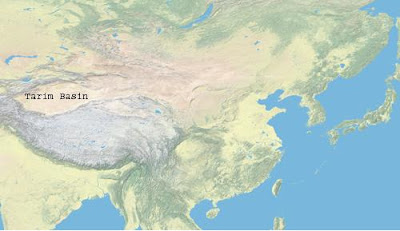Wake Up, China
On February 23, 2011, Drs. Jacque DeLisle and Nancy Steinhardt gave a fascinating short presentation in the Arthur Ross Gallery entitled “Post-Mao Dreaming: Chinese Contemporary Art.” Steinhardt introduced contemporary painting styles and themes, followed by a discussion by DeLisle about how the dominant themes are displayed on the socio-political stage of modern China.
Steinhardt boldly stated that the ideals of the People’s Republic of China still grip society, specifically, art, today in China. She evidenced this by drawing upon the paintings in the gallery to prove that Chinese art has not broken from its past, especially from the ideals firmly instilled during the Chinese. She compared many sets of paintings, in which themes were consistent from century to century, including the lotus, a common Buddhist image, and landscapes. She also cited the ease with which she could find images of the Tiananmen Square on June 4 (六四事件) as a part of this. See the paintings on display to understand the commonalities between China’s older and contemporary works.
DeLisle introduced the 2008 Olympics in Beijing, “One World, One Dream” (同一个世界,同一个梦想), as a prime modern example of how China’s culture today has not broken away from its past. There were many artistic endeavors, especially those in architecture and ceremonies, each of which became an incredible image of the Olympics in its own right. The most impressive structures were probably the Beijing National Aquatics Center and Beijing National Stadium, colloquially known as the Water Cube and the Bird’s Nest, respectively. The opening ceremonies, choreographed by Zhang Yimou, were hailed as possibly “the greatest ever.” The Olympics were supposed to symbolize China’s opening up to the world, and the economic and social progress it had made since the communist party takeover, and since June 4, 1989. The Olympics showcased China’s new wealth, its trade-driven economy, and its newfound tolerance for other cultures.
The Olympics also focused some criticism. The Olympics also put the spotlight on less glamorous topics in Chinese history, such as the millions of victims of Mao’s Cultural Revolution, the independence of Taiwan, the corruption throughout the bureaucracy, increasing wealth disparity, and displacement of families that came as a byproduct of construction for the Olympic venues. Finally, the two buildings, the Water Cube and the Bird’s Nest were predominantly designed by foreign architecture firms, with the assistance of Chinese architects, namely a consortium made up of PTW Architects (an Australian architecture firm), Arup international engineering group, CSCEC (China State Construction Engineering Corporation), and CCDI (China Construction Design International) of Shanghai and Jacques Herzog and Pierre de Meuron of Herzog & de Meuron, respectively. These foreign designs did not prove anything incredible about China’s social progress over the past several decades.
The Olympics were, if nothing else, proof that China has not fully departed from its past. DeLisle characterized China as being a “proud, insecure, nationalist” state. This is a practical assessment of China’s cultural presence on the international stage.
Nancy Steinhardt is a Professor of East Asian Studies with a focus on East Asian art and architecture. Jacques DeLisle is the Stephen A. Cozen Professor of Law and Chair of the Center for East Asian Studies where he focuses on law and political reform in China. The exhibition runs January 22 through April 3, is located in the Arthur Ross Gallery in the Fischer Fine Arts Library, and is free to the public.
- F. Miller, SAS 2013
Penn Current: http://www.upenn.edu/pennnews/current/about/020311.html

Comments
Post a Comment
We follow the House Rules as outlined by the BBC here.